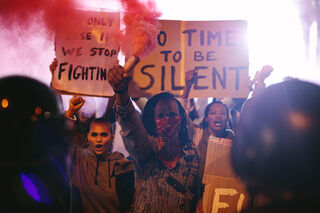KEY POINTS
- Anger can communicate information quickly and dramatically.
- Moral outrage is often a positive force for change.
- However, chronic anger and narcissistic rage can breed anger in others.
“Madness is better than sadness,” were Harold’s first words upon recovering from a catatonic state in a psychiatric hospital, years ago. When Harold was asked what he meant, he responded, “When you’re mad, you can do something, but when you’re sad you can’t do anything at all.” By madness, he was referring to anger, not insanity.
Harold was talking about the energizing effects of anger in contrast to the energy depletion that typically accompanies sadness. When you’re angry, you’re ready for action. You want to fight, throw something, or head for the hills at top speed. Energy pulsates through your body looking for an outlet. Sadness, on the other hand, has the opposite effect. It robs you of energy and leaves you staring out the window, crying silent tears.
Conflicts About Anger
In Harold’s case, he was immobilized not only because of sadness but because of conflict. His wife of many years had left him, and he was conflicted about her desertion. Vacillating between sadness and anger, he was unable to move. Just as Shakespeare’s Hamlet was immobilized and indecisive after his father’s murder and his scheming mother’s sudden marriage to his murderous uncle, so Harold was caught up in conflict. To be sad or angry is often the question.
Sensitive, intelligent, and introverted people are often conflicted about anger. Taught to be polite and compassionate toward others, they are inhibited and anxious when angry. Not comfortable in expressing anger directly, they are more at home with sadness. Because sadness typically has no motivational charge, they feel hopeless about changing any aspect of the loss, disappointment, or frustration.

Source: Fizhes/iStock
Constructive Anger
An example of the motivational impetus of anger occurred in a workshop, where a forty-five-year-old, overweight, passive woman talked sadly about her marital unhappiness. During one exercise that dealt with her feelings about her husband, she got visibly angry and chased the stand-in for her husband out of the room. While the transformation from sadness to anger was dramatically apparent in her red face and loud voice during the workshop, what was most surprising was her weight loss that year. She lost a grand total of 40 pounds and got a new, more satisfying job. Her anger provided the motivational thrust that she then used for highly constructive ends.
In a similar transformation, a woman lawyer was overwhelmed by debilitating grief over the rejection by the “love of her life.” At the time they were dating, he had been secretly involved with another woman, whom he finally decided to marry. Her sadness persisted for months until one day she received a perfunctory apology from him in the mail. At that moment, she experienced a surge of such intense anger that she was finally able to let go of her attachment and move on. The old expression—”Hell hath no fury like a woman scorned”—is not only valid but fury can be highly productive when it is wedded to positive outcomes.article continues after advertisement
Besides the motivational boost that often accompanies anger, expressing anger directly communicates information more intensely and more quickly than any other message. When someone around you is angry, your ears perk up and you listen attentively. Anger amplifies the message; it turns up the volume of the communication. Anger is both riveting and powerful. Because anger can be dangerous, it puts you on red alert trying to assess the danger in a particular situation.
However, when anger is expressed in a restrained manner (no screaming at the top of one’s lungs, throwing things, hitting, or name-calling), the situation can be improved after an angry confrontation. If the recipient of anger is not a blamer, he or she can come to a new realization of the situation and try to make up for any mistakes. As for the person expressing anger directly, there is a sense of relief—a feeling of authenticity. Something important got said, and if no one was permanently hurt, there is nothing to worry about. Helplessness vanishes; you are in control once more and ready to move forward.

Source: Jacoblund/iStock
Moral outrage can be another kind of constructive anger. Moral outrage takes place when frustration and disappointment are joined by a deep-seated sense of injustice. Typically, religious and ethical principles are involved. Morally outraged persons see themselves as victims of a profound offense to their dignity as human beings. Recent examples of moral outrage that spawned widespread movements are the Me-Too movement, Black Lives Matter, and gun violence protests. Many of the parents who lost their children in the Sandy Hook mass killings in Newton, CT in 2012, for example, became anti-assault weapon activists and devoted their lives to this cause.
Destructive Anger
Mass killings perpetrated by paranoid individuals are horrific, contemporary examples of destructive anger. These perpetrators are typically blamers who attribute their misfortunes to specific persons or the society-at-large. In addition, these angry individuals are often loners who lack a conscience. Antisocial personality disorder, which refers to a pervasive pattern of disregard for the rights of others, lack of remorse, deceitfulness, and impulsivity, and paranoid personality disorder are typical mental health diagnoses for these killers.article continues after advertisement
While personality predisposing factors are common along with social isolation and a desire for fame and notoriety, there is usually a precipitant—a recent event that throws the chronically angry individual over the edge. The precipitant ordinarily involves a dramatic loss of self-worth, as in a job firing, a betrayal by a romantic partner, or humiliation by significant others.
Besides these dramatic examples, more common instances of destructive anger are perpetuated by narcissists and other chronically angry individuals, including domestic violence abusers. These groups severely damage the people around them. Their friends and relatives, subjected to chronically angry environments filled with cursing, door slamming, and often physical assault, become overwhelmed by such ongoing outbursts and wind up angry themselves. Just as second-hand smoke is dangerous, so chronic anger is toxic to those living in its vicinity.
In Summary
Anger will always be a part of human nature, but it doesn’t have to be dangerous unbridled anger. When tempered with restraint, anger can change interpersonal dynamics. When coupled with justice, it can be a powerful voice for change. But when mixed with narcissistic entitlement and paranoia, anger can be a destructive tool that perpetuates the endless cycle of violence that never sleeps.
References
This post is adapted from an essay, “When Is Madness Better than Sadness?” published in Beyond Pipe Dreams and Platitudes: Insights on Love, Luck, and Narcissism from a Longtime Psychologist, Outskirts Press, 2021.
Source


Recent Comments